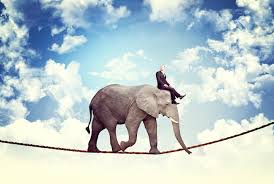According to author Richard Dobbs (No Ordinary Disruption) in 1950 a company occupied its place on the Standard & Poor’s 500 Index (S&P 500) for an average of 60 years. By 2011 that span had dropped to 18 years. More concerning is that Dobbs predicts that by 2027, 75% of currently listed companies on the S&P 500 will have fallen off the listing.
This points to increasing levels of churn and turbulence for big organisations. In essence it means shorter lifespans and certainly shorter periods of sustained success. So whilst people may be living longer, companies’ lifespan is shrinking.
 There are numerous reasons for this changing landscape. The growing complexity of the globalization and inter-connected economies; fractured markets; and an increasingly even playing field for smaller, more nimble companies and start-ups being just some of the more obvious reasons underpinning this reality.
There are numerous reasons for this changing landscape. The growing complexity of the globalization and inter-connected economies; fractured markets; and an increasingly even playing field for smaller, more nimble companies and start-ups being just some of the more obvious reasons underpinning this reality.
But what can you, as a leader, do to help arrest this trend when it comes to your own company?
Well, as it turns out there are some things that leaders can pay attention to in order to secure a greater chance of staying ahead of the curve. Much of it requires challenging conventional wisdom and the status quo and none of it is easy.
It requires linking the ‘theory’ to the ‘practice’ of what it really means to be a ‘learning organisation’. Everyone knows that in a context of exponential change being adaptable is essential. Adaptability hinges on being open to new learning and a great deal has been said and written about the importance of being a ‘learning organisation’. The challenge is that all too often there is a significant gap between the rhetoric and the reality.
Here then would be three things to pay attention to if you are to close the gap between the rhetoric and the reality within your own organisation.
1. Challenge current success
The problem of current success is that it very quickly can lead to complacency. Scaffolding is put in place to maintain the success (for obvious reasons) but it is this same scaffolding that then becomes harder and harder to dismantle after it has served its purpose. The props built around the success make challenging it difficult if not politically dangerous and soon talk of innovation, experimentation and learning become merely that, talk. Clichés such as, ‘don’t fix it if it isn’t broken’ become entrenched and the will to challenge the status quo dissipates and isn’t appreciated or welcomed. Today’s success can be the biggest impediment to tomorrow’s success.
2. Recognise your own bias
At a personal level this becomes one of the most important, if not the most important of personal attributes in securing learning and growth. At a company level an inbuilt and unchallenged bias can be a dangerous thing, if that is, the aim is constant adaption and innovation. There are of course many forms of bias one of which, the ‘attribution bias’ is worth mentioning. The attribution bias takes credit for success but places the blame elsewhere for failure. It is widespread and common and when present, means that the ability to learn from failure is non-existent. In any adaptive process this becomes a real danger when there is a deliberate unwillingness to ‘own failure’ and more importantly, learn from that failure. In organisational culture where success is lauded, paraded and dominant, failure goes unrecognised, excused and therefore unhelpful when it comes to learning and adapting. The offshoot of this is that people fear innovating for the majority of innovation ends in failure. You can see the problem. Companies need to reward the innovators – the failures; companies need to learn how to fail quickly and in a manner that doesn’t destabilise the entire operation but not to fail is simply not an option. Not that is if you wish to be adaptive in a changing world.
3. Instill an ‘open mind-set’
Some individuals naturally possess an open mind-set, many don’t. For many the world is ‘black and white’ or ‘right or wrong’ and very little will convince them otherwise. The reality is we are increasingly living in a paradoxical world or what futurists term an, ‘ambiguous’ world. In such a context an open mind-set is an important attribute. An open mind-set is willing to question, to challenge, to explore alternatives. It is willing to engage in processes that to others are a ‘waste of time and energy’. An open mind-set is fundamental to new learning and to really ‘seeing’; it is where understanding is more important than judging and ‘being right’. It is possible for an organisation to have such a mind-set but only if this mind-set is modeled at the highest levels. To do so gives implicit permission for it to be imitated throughout the organisational structures. Dator’s second law of futures states: ‘Any useful idea about the future needs to appear ridiculous’. An open mind-set is increasingly tolerant and welcoming of ‘ridiculous ideas’. How many ridiculous ideas surface in your meetings and deliberations? How are they received? It is worth noting that Dator does add that, ‘not all ridiculous ideas are useful’!
Of course there is a lot more to being a learning or adaptive organisation. The above points represent merely a starting point. Smart leader recognise that this agenda just might be their most important of all agendas. Smart leaders pay careful attention to driving this agenda and are intentional in their own leadership practice when it comes to displaying such attributes.
Be a smart leader.

